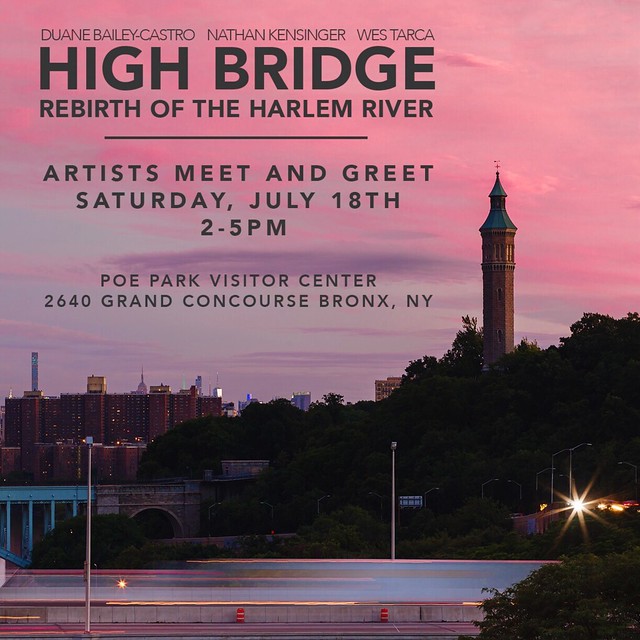Jose Gaytan: Love Letter to Brooklyn
 The following essay was published in the Spring 2012 issue of Overflow Magazine. The print version of the magazine featured an eight page spread of images by photographer Jose Gaytan.
The following essay was published in the Spring 2012 issue of Overflow Magazine. The print version of the magazine featured an eight page spread of images by photographer Jose Gaytan.Love Letter to Brooklyn
Written by Nathan Kensinger
Photographs by Jose Gaytan
Overflow Magazine, Spring 2012
The murky waters of the Gowanus Canal are an unlikely lure for creativity. In spite of a century of pollution, a diagnosis of gonorrhea, and a history of spontaneous combustion, the canal has drawn artists to its banks for many decades. One of the foremost of these artists was Jose Gaytan, a photographer who lived just uphill from the waterway in a classic Park Slope brownstone. Gaytan photographed the canal nearly every day, until his recent death from cancer at age 61.
When Gaytan first moved to the area in 2002 from Manhattan, he wasn't sure how to spell Gowanus. But he soon found the canal to be a source of inspiration that would change his life. It started with his daily dog walks down to the water, and soon became a creative obsession. As Gaytan began bringing his camera to the canal, he discovered a rapidly changing landscape, and knew he needed to document it.
Over the course of the past 10 years, a slew of new hotels and luxury condominiums have encroached on this historically industrial neighborhood, bringing crowds to new bars and venues on once quiet streets. Jose Gaytan saw these changes, but focused his lens on a different side of the canal, capturing the decaying industrial landscape. "Many have taken photos of the Gowanus Canal," said Katia Kelly, publisher of the Brooklyn blog Pardon Me For Asking. “But I could sense immediately that his relationship with this industrial waterfront area went deeper. He seemed compelled to document every square inch of the area."
 Photograph by Jose Gaytan
Photograph by Jose GaytanPhotography meant everything to Jose Gaytan. It was his livelihood, his passion, and even the source of his marriage. He met his wife, Lisa Gaytan, while teaching a black & white photography class at the International Center of Photography. Their first dates were photo shoots, hauling equipment to the Brooklyn Bridge, waiting for the soft glow after sunset. Gaytan collected cameras of all kinds – from the newest digital equipment to antique film models – and was an expert in their use. He worked for years as a photography salesman and a freelance photographer.
His personal photographic projects focused on the waterfront of New York City. He was "drawn to gritty landscapes," said Lisa Gaytan. He photographed bridges under repair, the collapsed West Side Highway, and a series on Williamsburg, Brooklyn in the 1980's, "when there were wild dogs running up and down Kent Avenue," according to Lisa Gaytan. The allure of the Gowanus Canal, with its abandoned buildings, empty lots and crumbling infrastructure, was not hard to understand.
 Photograph by Jose Gaytan
Photograph by Jose GaytanDespite his many decades of photographic work, critical acclaim eluded Jose Gaytan until almost the end of his life. His first solo exhibit was at age 58, at the Brooklyn Public Library, with an overview of his Gowanus photographs titled Brooklyn in Transition: A Photographic Essay of the Gowanus. The exhibit "was his major breakout," said Lisa Gaytan, and "was such an important thing for him." He worked day and night to prepare for the show, shooting and printing an enormous catalog of images.
The exhibit opened June of 2009 and presented a collection of sublime Gowanus landscapes. Inky clouds, brilliant sunsets, crusty tires, beautiful decay. It was a unique take on a toxic waste site. At the library, responses from visitors "ranged from a sense of wonder, to disbelief that this was the same Gowanus that most Brooklynites were familiar with," said Barbara Wing, Director of Exhibitions at the Brooklyn Public Library.
The exhibit received a glowing review from the New York Times, which compared Gaytan's photographs to the Impressionist canvasses of Pierre-Auguste Renoir. “I loved that he was in this corner of the city - that is usually written off as some polluted hellhole - finding moments of serenity,” said David Gonzalez, an editor at the New York Times photojournalism blog Lens, who reviewed the exhibition. "His palette was sophisticated, betraying a master’s understanding of light and color. Jose was an underappreciated master."
 Photograph by Jose Gaytan
Photograph by Jose GaytanThe exhibit and the NY Times review were “the culmination of everything he had worked for,” said Gaytan's friend Katia Kelly. "He was so excited." However, in just two years, an aggressive form of cancer, multiple myeloma, created a host of complications which would keep him from continuing his photographic work.
“I think he knew that he didn't have any time left,” said Lisa Gaytan. Unable to go out and shoot on the Gowanus, he began scanning negatives late into the night, trying to organize his vast photography archive from the past 40 years. Last December, Gaytan died. Some of his final words, according to his close friend Angel Franco, a New York Times photographer, were: "I love photography."
Gaytan was unable to finish organizing his archives before he died. Scattered around his office, on hard drives and in boxes of slides, there is a treasure trove of surprises from the Gowanus. They reveal a patient photographer, circling his subject, considering it from all angles. "Photographing the Gowanus was his love letter to Brooklyn," said Lisa Gaytan. "I’m very proud of what he did."
 Photograph by Jose Gaytan
Photograph by Jose Gaytan





This is beautiful. I can't wait to see the show.
ReplyDelete